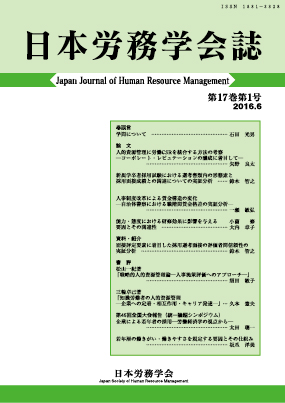The subject of this thesis is to clarify the actual condition of production skills acquired by operators (general workers) in the production site. A case analysis was conducted for a certain stainless steel plant (Factory B of the Company A).
Regarding to skill formation and skill distribution, the following facts have been already pointed out: i) the skill level of the general worker in the production site impacts the productivity of the workplace; ii) “intellectual skill”, the ability to deal with some changes and/or unusual circumstances, is especially important; and iii) the aforementioned skills are formed through the broad range of On-the-Job Training (OJT) and the appropriate management systems of human resource. However, I found that there are some unsettled issues including how the advanced skill was possessed by whom with what degree of ability. Therefore, I conducted the analysis to study the influences of individual attributes, such as one’s educational background and the age, on the skill distribution. The outline of the analysis is as follows.
The analysis was conducted based on the evaluation results for the skill level of all operators (543 persons) in the Factory B. I assume that i) the skill level and the years of experience of an operator correspond each other, since the skills are formed mainly through OJT; and ii) many operators possess the skills required. Therefore, I firstly studied for the distribution of skill levels. As a result, “medium-thick shape” with an experienced-operator group as the center of the distribution was quantitatively observed. Then, I conducted a quantitative analysis regarding the determining factors for the skill level. As a result, it was confirmed that the skill level of the majority of operators who possess the standard capability and work ethic is increased along with the years of experience; and the operator will reach the level 3.5 after about 25 years of service length. The level 3.5 is close to the level 4, the standard level for an operator which shows that an operator has enough skill to conduct problem solving and maintaining operation. Moreover, for the attributes of workers, it was found that their educational background has hardly impacted on the skill formation. However, it was also found that availability of overhead-crane license effects significantly to the skill formation. Consequently, it is suggested that a certain level of intelligence and motivation for skill improvement of operators is important for the “intellectual skill” formation.
Since the facts that the skill distribution shows “medium-thick shape” and the majority of operators will obtain the sufficient level of skills after about 25 years of service length, it is suggests that there is little variability in the individual level of skills obtained. On the other hand, in general, the personnel rating in the ability-based grade system will differ in proportion to the length of one’s service. Consequently, I assume that requirements for evaluation conducted by a company would exist in other than “intellectual skill”. Regariding this question, it is considered that one of the influential answers is the following; “some blue-collar workers are expected to obtain “management skill” including leadership capability in the late stage of their career.”
View full abstract
